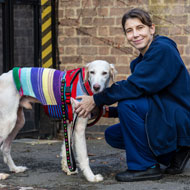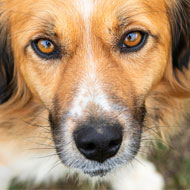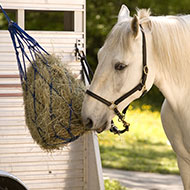One in every 250 dogs is affected by 'dry eye' disease.
Findings show that brachycephalic dogs and spaniels more likely to develop the condition.
Brachycephalic dogs and spaniel breeds are more likely to have 'dry eye' disease, the RVC finds. Keratoconjunctivitis sicca (KCS) – more commonly known as dry-eye – causes dull eyes, and can lead to blindness if untreated.
Including 363,898 dogs, the study, led by the RVC's VetCompass Programme, is the largest of its kind, using anonymised veterinary health records to explore dry eye in dogs. These dogs were followed for a year, with 1,456 dogs identified as being affected with the condition.
Dry eye is a condition in which a dog is unable to keep their eyes lubricated, as they are unable to produce tears. Resulting in highly painful eye ulcers, eye infections, and sore eyes, dry eye even causes some dogs to go blind or need their eyes removed. Dogs diagnosed with dry eye will need treatment and medication over the course of their entire life to maintain their sight.
The study's findings show that brachycephalic dogs and spaniel breeds had a greater risk of dry eye overall. The RVC have found that the worst affected breed in its study is American cocker spaniels, with one in 17 dogs affected. Similarly badly affected dogs include English bulldogs, with one in 55 dogs affected, pugs – with one in 110 dogs affected, and Lhasa apsos, with one in 54 dogs affected.
Dr Dan O'Neill, senior lecturer and author of the paper, said: “We all love those glossy puppy dog eyes, but this study shows that sadly not every dog enjoys good eye health. This research identifies that flattened faces in some breeds makes these breeds more prone to this painful dry eye condition. Work is urgently going on to improve the health of many of these flat-faced breeds, but in the meantime the message from everyone who cares about dogs is to ‘stop and think before buying a flat-faced dog.”
There are several other key findings in this study. It was found that overall, one in every 250 dogs suffer from dry eye, and that 22 breeds showed an increased risk of dry eye.
Also found in the study was the fact that dogs twelve years old or older had the highest risk of dry eye, a 30 per cent higher risk compared to dogs under the age of three.
European specialist in veterinary ophthalmology, Rick Sanchez, said: “Taking a fresh dip into an old, dull looking disease like KCS has shown us there is more for us to learn than we thought. Ultimately, all of us, clinicians, nurses, researchers, breeders and dog owners are, in one form or another, care givers for our beloved animals. All of us need whatever new information we can set our eyes on to inform our next steps in improving canine ocular health.”
Bill Lambert, health, welfare and breeder services executive at The Kennel Club, commented: “These findings are important to help us to identify which dogs are most at risk of developing dry eye. Ultimately, this should help owners that may need support in spotting the initial signs, as well as ways to treat affected dogs and how to prevent it occurring in the future. The data from this fascinating research will also be used to collaboratively create strategies to tackle health priorities with the breed clubs of affected breeds.
“We hope this research, funded in part by The Kennel Club Charitable Trust VetCompass grant, helps to improve dog welfare across the board, raise awareness of KCS and reduce the impact of this disease.”
The authors of the study have made recommendations to veterinary professionals to help reduce the impact and frequency of KCS by testing the adequacy of tear production as a part of the annual physical examination of all dogs as they approach advanced age.
The paper, which is freely accessible, can be found here at onlinelibrary.wiley.com







 The BSAVA has opened submissions for the BSAVA Clinical Research Abstracts 2026.
The BSAVA has opened submissions for the BSAVA Clinical Research Abstracts 2026.
